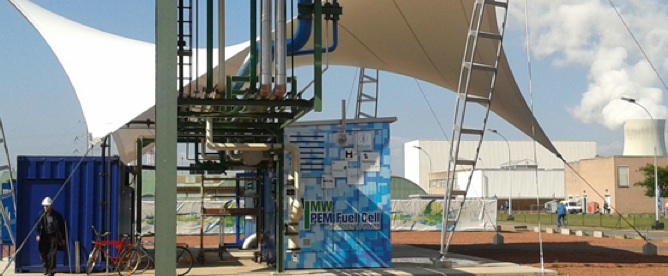Image Credit: Nedstack (all images)
Image Credit: Nedstack (all images) Solvay’s PEM rigged for loading onto a flatbed truck, which shipped the system to its testing site at an industrial plant in Lillo, Belgium. The PEM — actually 12,600 fuel cells packed into a single power plant — has generated over 500 MWh in about 800 hours of operation.
A fuel-cell demonstration project in Belgium has managed to generate enough electricity to power over a thousand homes. The successful demonstration was a victory for Belgium-based chemical company Solvay and WaterstofNet, one of the agencies that helps guide renewable-energy development in Europe’s Flanders and Netherlands regions through an initiative called Project Hydrogen Region.
Last week, Solvay highlighted the power-production rate of a 1 MW proton exchange membrane (PEM) fuel cell that was installed last year at plant operated by Solvay subsidiary and vinyl plastics specialist SolVin in Lillo, Antwerp. The PEM, Solvay says, has generated more than 500 MWh in about 800 hours of operation, or enough electricity to power about 1,370 homes during the 33-day time period. (SolVin is 25% owned by chemical company BASF.)
Fuel cells — which use an oxidizing agent such as hydrogen for fuel and, through chemical reaction with an anode catalyst, produce electricity and then, in a second reaction, usually with oxygen, water or carbon dioxide — have been around since the 19th century. In recent decades development of fuel cell technology has been embraced for its potential as a relatively clean energy source.
Fuel cells on a large scale
Usually powered by natural gas, a good source of hydrogen, fuel cells are fairly widely used in commercial vehicles and forklifts, and in a few cases they have been developed to generate electricity for commercial buildings. The PEM supplying power to the SolVin factory is billed by Solvay as the largest in the world — a significantly scaled-up unit comprised of 12,600 fuel cells.
Nedstack, one of the companies that helped build the PEM using Solvay specialty polymers and its SolviCore membrane electrode assemblies, noted that “electrical efficiency has proven to be 50%, with a total efficiency — including heat recuperation — of 80%.”
Project Hydrogen Region has a total budget of $18.4 million financed by the European Union, the Flemish government, the Dutch government, and industry participants. Project Hydrogen Region contributed about $1.9 million to Solvay’s fuel cell project budget of $6.6 million. WaterstofNet hopes to use the project for further research and leverage its success to help fund the development other fuel cell systems.
Weekly Newsletter
Get building science and energy efficiency advice, plus special offers, in your inbox.












0 Comments
Log in or create an account to post a comment.
Sign up Log in